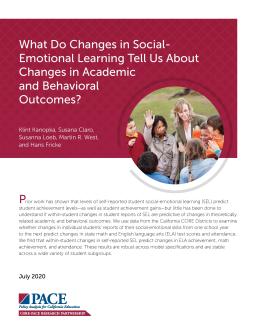Lessons for COVID-19
Published
Summary
This brief discusses the impact of the COVID-19 pandemic on student absenteeism and academic and social-emotional outcomes using panel data from California's CORE Districts. Absenteeism has a negative effect on student outcomes, with math being more affected than English language arts, and middle school students suffering more than elementary or high school students. The study also shows that absenteeism negatively impacts social-emotional development, which can have further implications for student outcomes.
Published
Summary
This study used data from California CORE Districts to explore whether changes in students' self-reported social-emotional learning (SEL) predicted changes in academic outcomes and attendance. The findings revealed that within-student changes in SEL were positively associated with improvements in English language arts (ELA) and math achievement, as well as attendance, and were consistent across various student subgroups.
Consistent Gender Differences in Students’ Self-Efficacy
Published
Summary
This brief examines the consistency of the drop in academic self-efficacy during middle school across various student groups, such as demographics, achievement level, and school of attendance. The study finds that the drop is essentially universal across all groups, despite some showing lower self-efficacy than others. Additionally, schools vary in their students' level of self-efficacy, but do not differ much in this trend. The drop in academic self-efficacy is steeper for female students, resulting in lower self-efficacy for girls than boys throughout middle and high school.
Published
Summary
This study uses value-added models to explore whether social-emotional learning (SEL) surveys can measure effective classroom-level supports for SEL. Results show that classrooms differ in their effect on students' growth in self-reported SEL, suggesting that classroom-level effects may be larger than school-level effects. However, the low explanatory power of the SEL models means it's unclear if these are causal effects. The SEL measures also capture growth not measured by academic test scores, indicating that classrooms within schools may impact measurable student growth in SEL.
Published
Summary
This report examines the stability of school effects on social-emotional learning (SEL) over two years in California's CORE districts. The correlations among school effects in the same grades across different years are positive but lower than those for math and ELA. While these effects measure real contributions to SEL, their low stability draws into question whether including them in school performance frameworks and systems would be beneficial.




